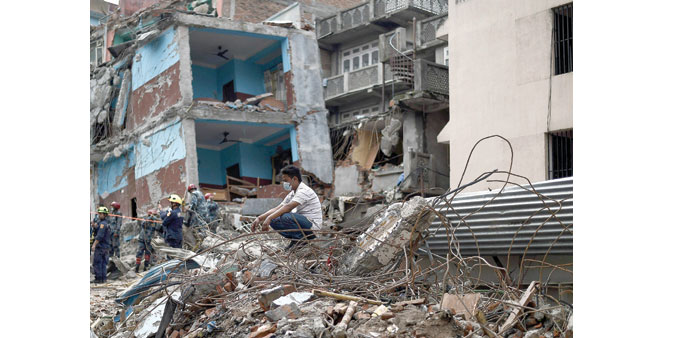GRIEF STRUCK: A Nepalese resident watches an ongoing search and rescue operation at a destroyed building site in Kathmandu on April 30. The UN launched an appeal for Nepalese quake survivors in dire need of shelter, food and medical care April 30 as anger boiled at the government’s inability to cope with a disaster that has killed more than 6,000 people. File photo by AFP PHOTO
By Steff Gaulter
The recent earthquake in Nepal shows the devastation that nature can bring. As the quake hit, the ground shook violently, sending centuries old buildings crashing to the ground. Thousands of people were killed and thousands more were trapped in the debris.
The enormous power of this earthquake makes it fairly rare. It was measured as a 7.8 magnitude quake and the last time that an earthquake this strong struck was in June last year, when a 7.9 magnitude earthquake hit Little Sitkin Island in Alaska. You probably didn’t hear about that quake though, as the island is only ten kilometres (six miles) in diameter and is unpopulated. There was a concern that the earthquake was going to generate a tsunami, but when it didn’t, the quake was largely ignored.
This year’s earthquake was very different, partly because it struck in a very populated area, but also because it was very shallow. It can strike anywhere from the surface to about 800 kilometres (500 miles) deep, and the closer to the surface it hits, the more damage it will cause. This is because the strength of shaking diminishes the further you are from the earthquake’s source, and therefore the strength of shaking at the surface from an earthquake that occurs at a depth of 600km deep is considerably less than a similar sized earthquake that strikes at 10km.
The earthquake that hit Nepal had a depth of just 15 km (9 miles). This is very near the surface and therefore caused very vigorous shaking of the ground. An earthquake this powerful and this shallow is almost certain to cause devastation no matter where in the world it strikes. In Nepal, however, the damage was worse than it might be in some other countries because of the rustic charm of the country. Many buildings are old and poorly constructed and sadly this will have led to more of them collapsing.
The small blessing was that the ground on which Kathmandu is situated is solid bedrock, which would have limited the amount of shaking that was felt. If the ground had been sandy or silty soil, then the situation could have been even worse. Fortunately the sandy soil was confined to the north Indian plains near the Nepalese border, where the population is far smaller.
The fact that Nepal is susceptible to earthquakes shouldn’t come as a surprise to anyone. The huge towering Himalayas are the clue to the fact that the rocks beneath the ground are pushing against one another. You can think of the earth’s crust as pieces of an egg shell; broken but still clinging to the surface of the earth. The individual pieces of ‘eggshell’ are of random shapes and sizes and they are all moving independently.
India is on one fragment of rock, and Europe and Asia are on another. These huge floating masses, or tectonic plates, are moving in different directions: the India plate is moving northwards into the Eurasia plate at about 4.5 cm per year. This causes the plates to buckle to such an extent that the Himalayas are still growing by more than 1 cm per year. However, the sliding between the plates isn’t smooth and the rocks grind together heavily as they pass. You can imagine this as if you are pushing a heavy piece of furniture across a carpet; the pressure would build up and up, until there is a sudden movement. That’s what happens with plates too, suddenly there will be a jolt, an earthquake, when the pressure gets too much.
Considering the movement of the rocks in the region, there have been surprisingly few major earthquakes. In fact, in the last century there have been just four which have been more than 6 in magnitude. Unfortunately, all of these have resulted in a very large number of fatalities, with the 8.0 magnitude quake in 1934 believed to have killed more than 10,000 people.
We should all be very grateful that Qatar is not in a particularly seismic active part of the globe, but having said that, earthquakes can be felt here. Those of you who were here in April 2013, may remember the excitement generated by the faint tremors we felt in Doha when an huge earthquake struck Iran. Although the earthquake caused major damage near its epicentre, in Qatar the quake could only really be felt in high rise buildings. Many of the towers were evacuated, and many of my friends were pleased to have an unexpected afternoon off work!
The strange thing about the tremor that we felt in Doha, was that exactly one week later there was another, again triggered by a powerful earthquake in Iran. To have two earthquakes on two consecutive Tuesdays was an uncanny coincidence. Some people of a nervous disposition began to dread the following week, but fortunately there was no seismic activity in the region in the next week.
Not working in a high rise building, the most I saw was the water sloshing around my swimming pool, like a rather lack lustre wave machine, and to be honest I don’t think I ever want to experience anything more powerful. My heart goes out for the people of Nepal, and for the thousands of people around the world who are now missing a family member.

